Because reptile enthusiasts usually focus their attention on the more attractive species, the less impactful animals often go unnoticed. Unfortunately
Because reptile enthusiasts usually focus their attention on the more attractive species, the less impactful animals often go unnoticed. Unfortunately, as we’re drooling over the beautiful eye-candy animals we see at reptile expos and stores, we fail to take into consideration some of the less-conspicuous members of the reptilian world. We end up missing out, because though they may not be as pretty to look at, some of these “plain” species can impact us in other ways. One such animal is the West African mud turtle (Pelusios castaneus).
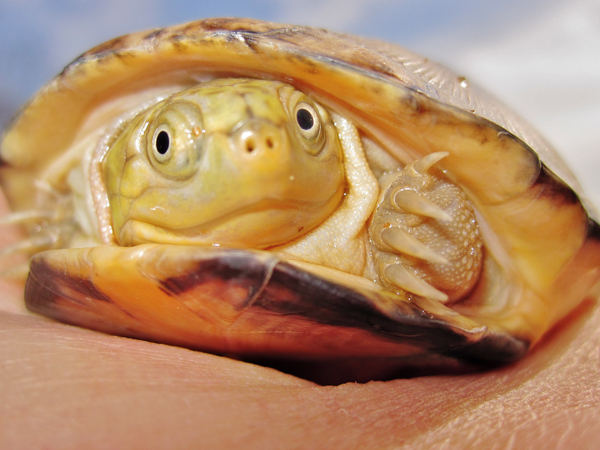
Chris Leone
The West African mud turtle has an endearing expression due to its “smile.”
Growing to a maximum size of about 11 inches, P. castaneus is one of the hobby’s easiest turtles to obtain, and it is a much more manageable species to keep when compared to main staples such as the red-eared slider. Plus, it’s packed full of personality. So how come we don’t hear more about it?
It’s likely because the West African mud turtle does not exhibit exquisite radiating lines on the carapace or highly contrasting skin patterns featuring brilliant reds, oranges and yellows. Instead, it’s brown—it’s brown, with a little more brown, in fact.
West African Mud Turtle Genus Pelusios
The genus name Pelusios means “mud,” and the West African mud turtle lives up to its name. Its smooth, elliptical carapace lacks any pattern and is a uniform dark to light brown. The legs and head are a dark gray to brown with a light reticulated pattern on the top of the head. Only when the turtle is viewed from the bottom does a color other than brown become more evident: a creamy yellow coloration can be seen on the soft parts beneath. The brown plastron is hinged and features some lighter areas among the brown.
Read More
West African Mud Turtle Care Sheet
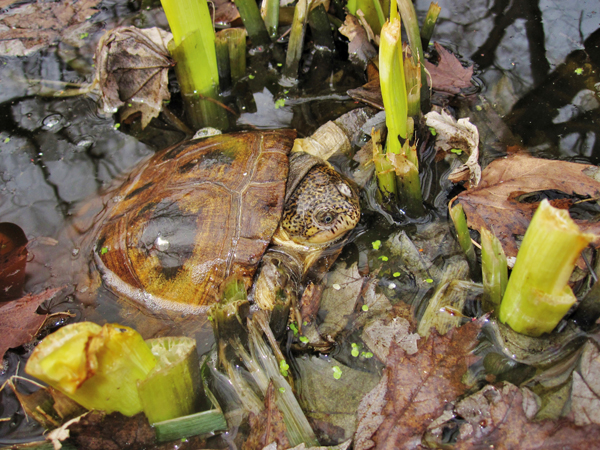
Chris Leone
Aquatic vegetation should be incorporated into West African mud turtle enclosures.
While just about every single wild Pelusios is some shade of dark brown, those that are born in captivity are sometimes surprisingly attractive. As the young, captive-born turtles grow, they become a uniform light cream color with highlighted areas of yellow or white. The darker coloration is lacking, and these juveniles appear to be nearly hypomelanistic. However, they sometimes darken when they are kept outdoors exclusively and exposed to natural sunlight.
Male mud turtles have longer, thicker tails than females, with a slightly concave plastron. Females have shorter, smaller tails and flat plastrons. The large, flat head and neck are withdrawn into the carapace sideways, giving this turtle its other common name: African side-necked turtle. The jaws are arranged in a way that displays a comical smile, similar to that seen in the Blanding’s turtle, and with minimal webbing, the strong limbs are equipped with sharp nails that enable these turtles to rip food items to shreds and to haul themselves onto land or floating debris.
For a long time, the West African mud turtle was referred to as P. subniger in captive collections. Pelusios subniger is actually a different species of mud turtle—the East African mud turtle—and is very rare in captivity. Though the two species are easy to confuse, P. subniger lacks any head pattern and its plastron exhibits a figure-8 shape; both characteristics can help you differentiate it from P. castaneus. Both of these mud turtles sport a hinged plastron, and this is one of the main ways to tell them apart from yet another similar turtle, the African helmeted turtle (Pelomedusa subrufa), which possesses a fixed plastron.
West African Mud Turtle Range
In nature, P. castaneus is native to West Africa (Angola, Guinea, Ghana, Senegal, Liberia, Sierra Leone, and the Republic of the Congo are just of few of the places they occur), where specimens are found in many aquatic habitats. Some of these dry up seasonally, forcing the turtles to aestivate deep down into the mud to wait for the return of the wet season. This is a robust, hardy species that is able to withstand extreme temperatures, stagnant water, major floods and severe droughts.
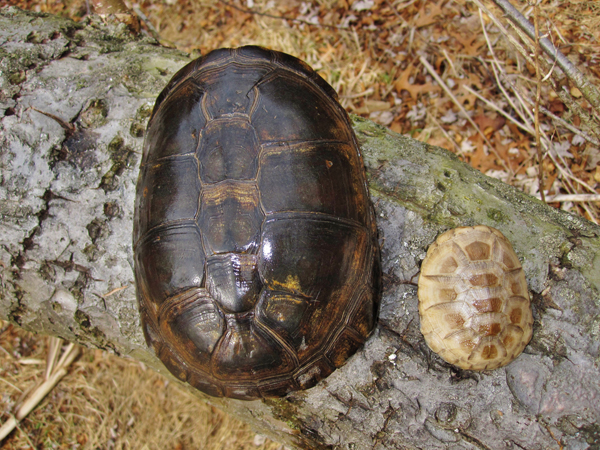
Chris Leone
The above two photos are evidence that captive-bred West African mud turtles can exhibit an attractive lighter coloration than their wild-caught counterparts. The lighter coloration of the smaller, captive-bred turtle may remain, or it may turn darker, depending on the turtle’s exposure to natural sunlight.
The West African mud turtle joins itself alongside some of the most primeval species of turtles having first walked the planet some 120 million years ago. Today, it remains on the IUCN’s list of species of “least concern,” meaning it appears to be doing rather well in nature. Perhaps it’s because of the turtle’s robustness, enabling it to escape nature’s wrath, or maybe even its drab appearance contributes to its survivability, allowing it to blend in with its environment and remain unnoticed by predators and collectors.
West African Mud Turtle Outdoor Enclosures
Due to the variety of aquatic environments it inhabits in its African homeland, where it may occupy everything from rivers to seasonal mud holes, P. castaneus is quite adaptable and does not appear to be very picky in captivity. It can be housed outdoors in the summer and where winters are mild, and will do very well in outdoor ponds or water gardens that get plenty of sunlight, thriving where temperatures stay in the high 70s and into the 100s (with nighttime in the mid 60s).
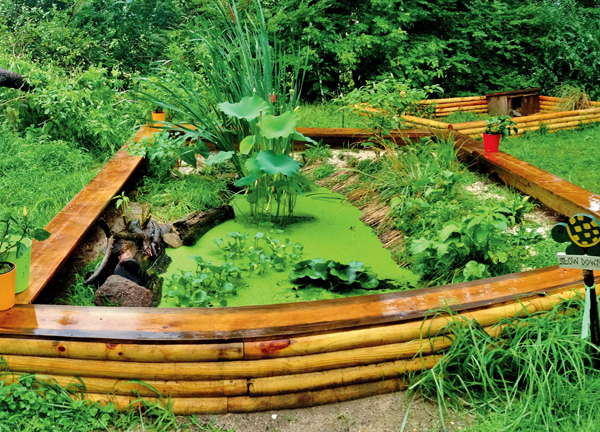
chris leone
Keeping West African mud turtles outdoors provides an opportunity to create some beautiful outdoor habitats.
Both of these attractive enclosures belonging to the author house Pelusios castaneus.
An outdoor enclosure measuring 10 by 10 feet can house up to eight adult turtles, with a water area accounting for 75 percent of the space. The remaining 25 percent can be planted with low-lying shrubs and grasses, and could be used by females as a nesting area. Like all outdoor turtle enclosures, security from predators and escapes is a must. A secure retaining wall measuring at least 18 to 24 inches tall can be made from pressure-treated wood, landscaping timbers, bricks or other strong materials. Sink the walls 8 inches into the ground to prevent the turtles from digging out.
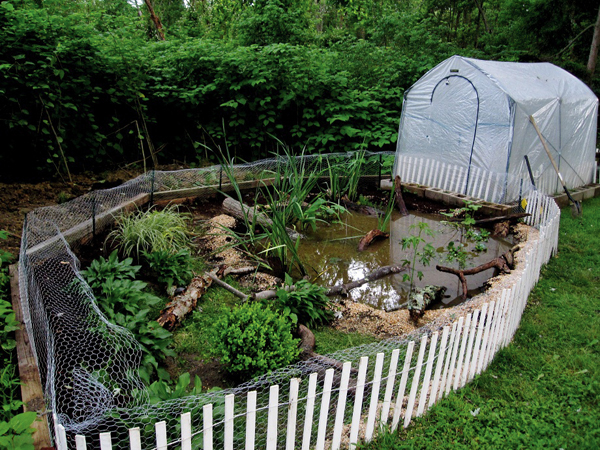
Chris Leone
Keeping West African mud turtles outdoors provides an opportunity to create some beautiful outdoor habitats.
Both of these attractive enclosures belonging to the author house Pelusios castaneus.
The water area should not be too deep because these mud turtles prefer to crawl along the bottom rather than swim in open water. A suggested depth of 8 to 12 inches, with a gradual slope to enable easy in-and-out access, works well. When digging the basin that will serve as the water area, having the deepest part in the center will allow the area surrounding it to be used as a gradual slope that will enable the turtles to move easily about the water and to safely enter and exit it.
After digging the basin, line it with a 45 to 65 millimeter-thick pond liner. Peat moss can be placed at the bottom and will allow the turtles to do some underwater burrowing. It will also provide aquatic vegetation a place to anchor its roots. West African mud turtles appreciate aquatic vegetation for cover; water lilies, anacharis, hyacinth and water lettuce are excellent choices. West African mud turtles are avid baskers, too, and their outdoor habitat should include logs and rocks for this purpose.
Predator-proof covers for the outdoor habitat can be constructed using 2- by 3-inch wooden framing that is then fitted with strong wire mesh. Set on hinges and equipped with latches, such covers will keep pesky raccoons and other harmful animals away from your turtles. Setting baited traps each night during seasons when such wildlife is active will coax predators into them and away from your turtles.
West African Mud Turtle Indoor Enclosures
West African mud turtles do well in all-glass aquariums, large Rubbermaid totes or bins, baby pools, troughs, stock tanks and custom-built enclosures. Whichever you choose, it’s important to provide the turtles enough space, especially when keeping multiple specimens. The rule of thumb when keeping any species is to go as big as you can, or at least as big as your inside space will allow (and if that’s not big enough, then you’ll need to consider the outdoor option mentioned previously).
For up to four adult turtles, an area measuring 6 by 3? feet and 125 to 175 gallons will usually suffice, but be sure to watch out for any turtle that is overly aggressive. Such an individual will need to be removed at once in order to avoid serious injury to the other turtles. West African mud turtles tend to be easy going and rarely attempt to bite, but a responsible keeper should always be on the lookout for potential problems. If you plan to keep just a single turtle a 40-gallon breeder tank would be fine.
The water depth does not need to be more than 8 inches, and it should include live or artificial plants to make the turtles feel secure. Driftwood, large cork bark slabs, river stones and logs should be positioned securely to provide the turtles a place to haul out, dry off and bask.
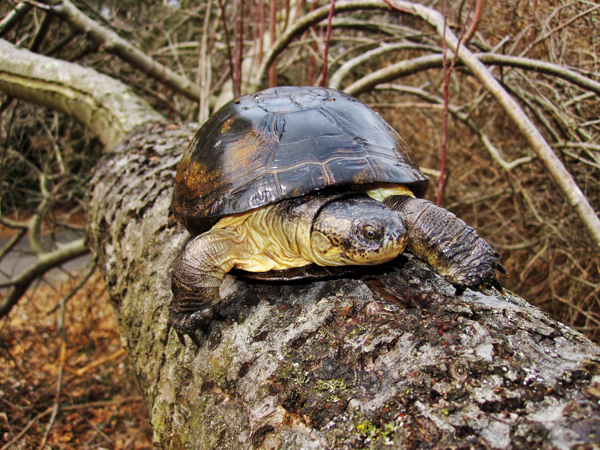
Chris leone
Pelusios castaneus has strong claws that it sometimes uses to climb. Keep this in mind when setting up outdoor pens; don’t place logs, etc., in areas that might allow the turtles to climb out.
I don’t use any substrate in any of my indoor aquatic turtle set ups simply because I prefer to keep things simple. A bare bottom is easier to clean when the water needs changing. West African mud turtles can be quite messy when feeding, and they will rapidly dirty the water. This is also why I don’t use filters; I prefer to do frequent water changes every few days.
If you want to use a filter, several reliable types can be found at pet stores and online, and some are designed specifically for use with turtles. Be sure to choose a powerful one with an appropriate flow rate of 350 gallons per hour, and be ready to clean it out often because it will clog up from time to time.
As mentioned, P. castaneus basks often, unlike other shallow-water, mud-dwelling turtles. In the wild, large numbers of them can be seen clustered along river banks, soaking up the powerful African sun. Those that are kept indoors must be provided with a powerful, heat-emitting bulb of 100 to 150 watts. Mercury vapor bulbs are my favorite because they also provide both UVA and UVB rays. These bulbs can be placed in ceramic fixtures, available at pet and home improvement stores, and positioned about 12 inches above the basking area. West African mud turtles will often spend hours under these lamps.
The basking area should be maintained at a temperature between 95 and 100 degrees Fahrenheit, with the ambient room temperature hovering in the low 80s. If your turtles are kept in a room that tends to be cool, also use a submersible water heater to warm the water in the enclosure to 70 to 75 degrees. Pelusios castaneus tends to be hardy and able to withstand significant temperature drops, but it should not be subjected to them for extended periods in order to prevent possible respiratory illness.
Hatchlings and juveniles can be housed indoors in the same type of set up as the adult turtles. The water should not be as deep, because they can drown at such a vulnerable age. I recommend a depth of 2 to 4 inches until the turtles are exhibiting significant growth. An abundance of aquatic vegetation should be provided, along with plenty of basking furniture. When the turtles have a carapace length between 3 and 4 inches, they can be moved to a predator-proof outdoor set up for the summer.
Adult West African mud turtles may attempt to nip, or even eat, very small youngsters, so do not house them with older turtles until they are at least 5 inches long.
West African Mud Turtle Diet
Healthy West African mud turtles are impressive consumers. If you make food available to them, they will eat it—all of it. They will beg for food and accept almost anything. Some fruits or greens are taken, but P. castaneus is much more inclined to strip a chicken leg or thigh of all its meat, skin and cartilage. Individuals become quite enthusiastic at feeding time and will leave the water to snatch a tasty item from your hands. I prefer to use tongs when feeding them because they can be rather overwhelming to deal with as they all come barreling toward me at the site of food.
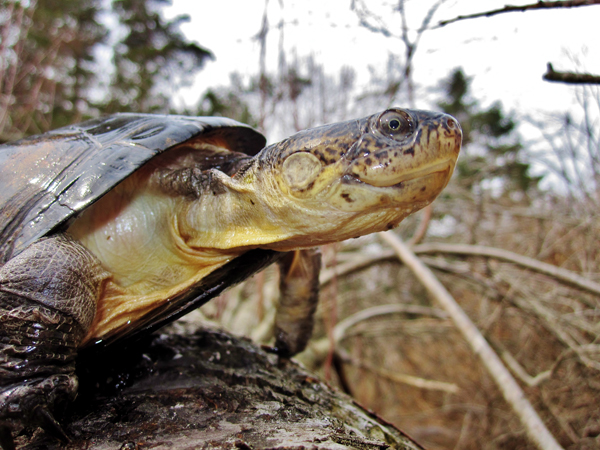
Chris Leone
Pelusios castaneus used to be referred to as P. subniger in the pet trade, but P. subniger—the East African mud turtle—is a different species that is rare in captivity.
Fish, shrimp, chicken, beef heart, pinky mice, whole skinned mice, dog and cat foods (sparingly) and koi pellets, as well as any commercial aquatic turtle pellets, are all devoured voraciously by West African mud turtles. They do not need to eat every day; feeding them every two to three days will suffice. They can become obese quickly, so be cautious when feeding. Don’t forget, too, that turtles kept outdoors will find a lot of their own food. They will hunt down tadpoles, frogs, worms and insects—and they will not hesitate to grab a small bird that lands at the water’s edge for a quick drink!
Baby turtles will accept all the above-mentioned foods, but it may be necessary to cut their food into more manageable pieces that the babies can swallow easily. Babies can be fed every day and will grow fast.
Keeping West African Mud Turtles
The West African mud turtle may not be littered with vibrant spots or stripes, and its general coloration doesn’t scream at you, but this compact and robust turtle is a lot of fun to work with. It’s an excellent candidate for a backyard waterscape, and isn’t fussy when housed indoors, either.
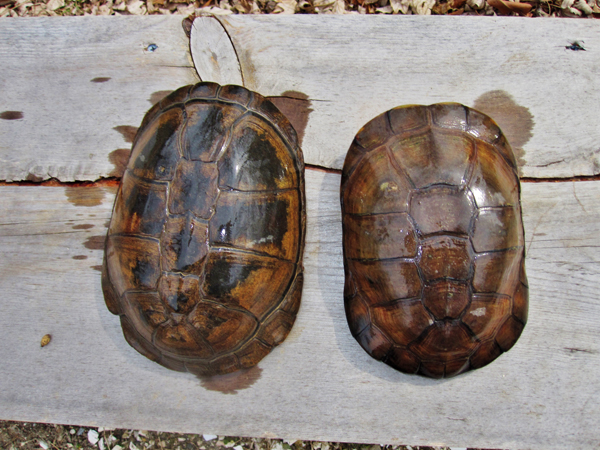
Chris Leone
The West African mud turtle resembles the African helmeted turtle (Pelomedusa subrufa). These photos of two males compare the carapaces and plastrons of the two species, with the helmeted turtle on the right.
Pelusios castaneus was designed for survival and adaptation, which makes it appealing to turtle enthusiasts looking for a problem-free species to keep as a pet. And what the West African mud turtle lacks in appearance, it makes up for in personality and ease of care. It has been kept successfully for decades and remains a favorite of many aquatic turtle enthusiasts, which is not a surprise. The turtle’s excitable reactions at feeding time, the humorous spectacle of several piling on top of each other while competing for the best basking site and its overall charm are traits that cannot be ignored.
The next time you’re in the market for a new turtle, don’t overlook this underdog. You just might end up being pleasantly surprised.
Chris Leone has kept and bred many turtle and tortoise species for more than 20 years. Visit him at gardenstatetortoise.com and hermannihaven.com.


